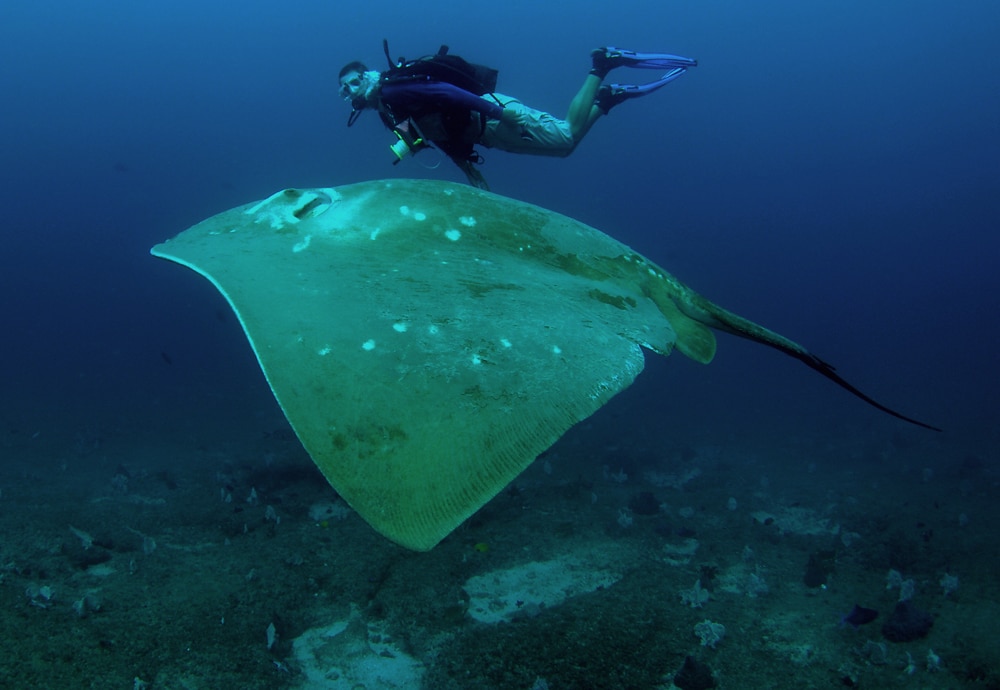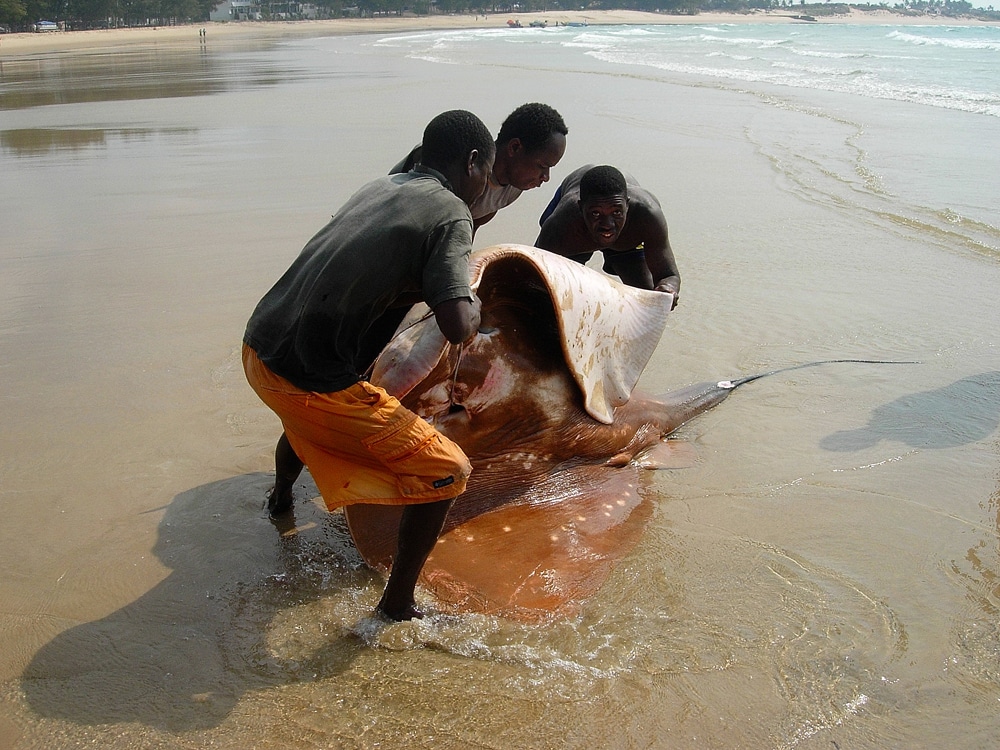News
First study of world’s largest marine stingray reveals long-distance migration

 Scientists use images and videos submitted by tourists to track rare species in Africa
Scientists use images and videos submitted by tourists to track rare species in Africa
Smalleye stingrays are the largest marine stingrays on record, reaching disc widths of up to 222 cm, and yet almost nothing is known about them. Scientists from the Marine Megafauna Foundation have for the first time used photo IDs to study this elusive animal in southern Mozambique, one of the only locations where it is regularly seen in the wild. Their findings were published in the journal PeerJ.
“We reported the first sightings of smalleye stingray in 2004 and have since been racing against the clock to learn more about their ecology before it is too late”, said Dr Andrea Marshall, co-founder and principal scientist of the Marine Megafauna Foundation. 31 percent of the world’s sharks and rays are threatened with extinction according to the IUCN Red List of Threatened Species ‒ due to lack of scientific effort and information, it has not been possible to evaluable the conservation status of smalleye stingrays to date. “This species of ray is likely in trouble too but we can’t protect what we don’t know much about. Our study is an important first step in understanding more about the animal’s ecology and behaviour“, she added.
“These mysterious giants are thought to be patchily distributed across the Indian Ocean and Western Pacific, but southern Mozambique is probably the best location to encounter them on inshore reefs”, Marshall added.
The marine biologists tested whether photographs of the stingrays’ (Megatrygon microps) white dorsal spots could be used to distinguish and track individuals over long periods.
“Through local dive centers, we called on tourists to help us collect images of this solitary stingray. Fortunately for us, southern Mozambique and its rich marine life attract many passionate scuba divers, most of which own GoPros or other lightweight cameras and will happily make their images and footage available for research”, said Atlantine Boggio-Pasqua who volunteered with the Tofo-based foundation.
She added: “Their contributions proved immensely valuable, we managed to gather more than 140 photographs suitable for comparison and identification, with some images dating as far back as 2003.”
The team was able to visually identify 70 different individuals, including 15 that had been seen on several occasions in the area. The dorsal spot patterns looked unchanged over the years indicating they may be permanent markings like in manta rays.
Boggio-Pasqua said: “Smalleye stingrays may look intimidating at first glance with their large, razor-sharp tail spines, but they’re actually really charismatic and easy to approach. We hope to receive many photo and video contributions from citizen scientists in future. They could tell us more about the species’ habitat preference as well as feeding and cleaning behavior.”
The encountered stingrays were often spotted at cleaning stations where reef bannerfish and other small fish appeared to be removing parasites from the rays’ skin.
The photographic study also provided a glimpse into the migratory behaviour of Megatrygon microps. Some individuals traveled hundreds of kilometers along the coastline, including a near-term pregnant female which traveled from Tofo to the Bazaruto Archipelago and back (200km in a minimum of 102 days and a total 400km return trip). She returned to Tofo, no longer visibly pregnant, suggesting this individual had pupped during her journey.
This proved to be the longest straight-line distance ever recorded for any species of whiptail stingrays (Dasyatidae family). Unlike other stingrays, smalleye stingrays are rarely seen resting on the seabed and are thought to be semi-pelagic.
Smalleye stingrays are likely under threat from increasing fishing pressures. Targeted and incidental catch in coastal gillnets and industrial purse seiners operating offshore are an ongoing issue in Mozambique.
“There are so many questions that remain unanswered about this rare species. Where do they live, how fast do they mature and how do they reproduce? Filling these knowledge gaps is crucial to figuring out how to protect them properly in Mozambique and other parts of the Indian Ocean”, concluded Dr Marshall.
Addressing the lack of available data will eventually allow scientists to formally assess the species’ conservation status in the IUCN Red List and inform management practices.
The study by Atlantine Boggio-Pasqua, Anna Flam and Andrea Marshall, titled ‘Spotting the “small eyes”: using photo-ID methodology to study a wild population of smalleye stingrays (Megatrygon microps) in southern Mozambique’ is published in the journal PeerJ on 11 June 2019 and is freely available here.
For more information about the work of the Marine Megafauna Foundation visit their website by clicking here.
Gear News
Introducing the TR-80, IR-50 and CS-30 Regulators from DYNAMICNORD

Whether you are a beginner or a professional diver – with the three new main regulators from DYNAMICNORD, everyone will find their favourite regulator. They all look super stylish.
Excellent performance with the TR-80
Quality and performance are the be-all and end-all for regulators. It is not for nothing that the TR stands for Tec Reg. The innovative design of the TR-80 guarantees absolute reliability – even in ice-cold waters.

Perfect breathing effort at 0.8 J/l / certified for diving in waters below 10 degrees / structural design made of solid brass for best cold protection / membrane-compensated design with dry seal of the first stage / reduced exhalation effort thanks to optimized exhalation membrane and bubble deflector / adjustable Venturi (dive/predive) and adjustment knob for individual inhalation comfort / innovative design of the front cover prevents free-flow in strong currents or when diving with scooters / design made of sandblasted brass, matt chrome finish / 2 HP and 4 LP outlets / mouthpiece made of high-quality, anti-allergic silicone for maximum comfort.


Amazing underwater adventures with the IR-50
The IR-50 is the top regulator for advanced and experienced divers. Natural breathing is the essence of this regulator.

Ideal breathing effort at 0.8 J/l /certified for diving in waters below 10 degrees / compensated membrane / adjustable venturi (dive/predive) and adjustment knob for individual inhalation comfort/ outlet valve and deflector for minimum exhalation effort and reduction of bubbles on the face / design made of sandblasted brass, matt chrome finish / 2 HP and 4 NP outlets / mouthpiece made of high-quality, anti-allergic silicone for maximum comfort.


The Workhorse – our CS-30
For diving centres and diving beginners – the workhorse stands for strong construction, reliability and robustness. Perfect for your training.

Optimal breathing effort at 0.8 J/l /recommended for diving in waters above 10 degrees / non-compensated piston / adjustable venturi (dive/predive) / outlet valve and deflector for minimum exhalation effort and reduction of bubbles on the face / design made of sandblasted brass, matt chrome finish / 1 HP and 3 NP outlets / mouthpiece made of high-quality, anti-allergic silicone for maximum comfort.


Octopus OP-30
The OP-30 is the ideal addition to all DYNAMICNORD regulators. It is identical in construction to the CS-30.

The TR-80, IR-50, CS-30 (DIN & INT) regulators and the Octopus OP-30 are available from DYNAMICNORD dealers and in the online store.
DYNAMICNORD – Your Outdoor Companion.
Marine Life & Conservation
Paul Watson Released as Denmark Blocks Japan’s Extradition Bid

Renowned anti-whaling activist Paul Watson has been released from custody in Greenland after spending five months in detention. Denmark’s Justice Ministry rejected Japan’s request for his extradition, citing insufficient guarantees that his time already served in custody would be credited against any potential sentence.
The 74-year-old Canadian-American was arrested on July 21 in Nuuk, Greenland’s capital, when his ship docked to refuel. His arrest was based on a 2012 Japanese warrant related to a 2010 encounter in Antarctic waters. Japan alleged Watson obstructed operations and caused damage to a whaling research ship during efforts to disrupt illegal whaling. Watson has consistently denied these claims, maintaining his commitment to marine conservation.
Denmark, which oversees extradition matters for Greenland, concluded that while the legal conditions for extradition were met, the lack of assurances from Japan regarding time-served credit made extradition untenable.
In a video shared by his foundation, Watson expressed gratitude and relief, saying, “After five months, it’s good to be out… and good to know they’re not sending me to Japan.” He added that the most difficult part of his time in custody was being separated from his two young sons.
Watson is a pioneering figure in marine conservation, known for founding the Captain Paul Watson Foundation in 2022 after decades of activism with the Sea Shepherd Conservation Society. His bold efforts to defend marine life have earned him widespread support, including from celebrities and conservationists. His work has also been featured in the acclaimed reality TV series Whale Wars.
Watson’s lawyer, Jonas Christoffersen, praised the decision, stating, “We are happy and relieved that Paul Watson is now free.” He added that Watson is eager to reunite with his family and continue his vital work.
The arrest occurred while Watson’s vessel, the M/Y John Paul DeJoria, was en route to the North Pacific with a team of 26 volunteers to intercept a Japanese whaling ship. His foundation described the arrest as politically motivated and emphasized that Watson’s actions were focused on ending illegal whaling practices.
Japan resumed commercial whaling in 2019 after leaving the International Whaling Commission, asserting that whale meat is a cultural tradition. Conservationists, however, continue to challenge these practices, highlighting their impact on marine ecosystems.
Despite the challenges, Watson remains steadfast in his mission to protect marine life and bring attention to whaling practices. His dedication to ocean conservation has made him a globally respected advocate for the environment.
-

 News2 months ago
News2 months agoIconic SS United States to become the World’s Largest Artificial Reef
-

 News3 months ago
News3 months agoBook Review – 52 Assignments: Underwater Photography
-

 Gear News3 months ago
Gear News3 months agoDYNAMICNORD – New German diving brand enters the British market
-

 News3 months ago
News3 months agoExploring Cenote El Pit: A Diver’s Dream
-

 Gear News3 months ago
Gear News3 months agoTry BARE drysuits (and maybe even win one!) this Friday with Sea & Sea at North West Dive Fest
-

 Marine Life & Conservation3 months ago
Marine Life & Conservation3 months agoBook Review: Coral Triangle Cameos
-

 Blogs2 months ago
Blogs2 months agoDive the Egyptian Red Sea this Autumn with Regaldive
-

 News3 months ago
News3 months ago2024 Ocean Art Underwater Photo Competition Announced

















